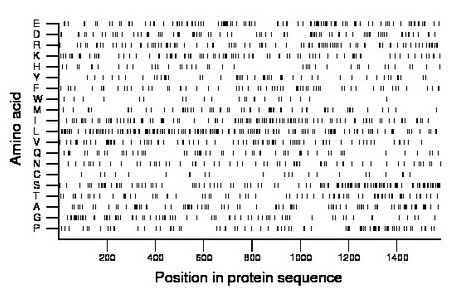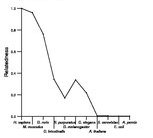
| Name: TRPM3 | Sequence: fasta or formatted (1579aa) | NCBI GI: 154091308 | |
|
Description: transient receptor potential cation channel, subfamily M, member 3 isoform f
|
Referenced in: Calcium and TRP Cation Channels
| ||
Other entries for this name:
alt prot [1569aa] transient receptor potential cation channel, subfamily M, member ... alt prot [1566aa] transient receptor potential cation channel, subfamily M, member ... alt prot [1707aa] transient receptor potential cation channel, subfamily M, member ... alt prot [1556aa] transient receptor potential cation channel, subfamily M, member ... alt prot [1544aa] transient receptor potential cation channel, subfamily M, member ... alt prot [1554aa] transient receptor potential cation channel, subfamily M, member ... alt prot [230aa] transient receptor potential cation channel, subfamily M, member ... alt prot [255aa] transient receptor potential cation channel, subfamily M, member ... | |||
|
Composition:

Amino acid Percentage Count Longest homopolymer A alanine 6.0 94 2 C cysteine 1.6 25 2 D aspartate 5.4 86 2 E glutamate 7.2 114 3 F phenylalanine 4.2 66 2 G glycine 5.0 79 2 H histidine 2.5 40 1 I isoleucine 6.7 106 2 K lysine 5.8 91 3 L leucine 10.1 159 3 M methionine 3.8 60 2 N asparagine 3.9 62 2 P proline 5.1 81 3 Q glutamine 3.7 58 2 R arginine 6.1 96 2 S serine 8.1 128 3 T threonine 4.8 76 2 V valine 5.4 85 3 W tryptophan 1.4 22 1 Y tyrosine 3.2 51 2 |
Comparative genomics:
Search single species RefSeq proteins at NCBI
Search summary 
Figure data | ||
Related human proteins:Protein Relative score Description Self-match 1.000 transient receptor potential cation channel, subfam... TRPM3 0.991 transient receptor potential cation channel, subfam... TRPM3 0.978 transient receptor potential cation channel, subfam... TRPM3 0.978 transient receptor potential cation channel, subfam... TRPM3 0.976 transient receptor potential cation channel, subfam... TRPM3 0.970 transient receptor potential cation channel, subfam... TRPM3 0.967 transient receptor potential cation channel, subfam... TRPM7 0.422 transient receptor potential cation channel, subfam... TRPM6 0.390 transient receptor potential cation channel, subfami... TRPM1 0.384 transient receptor potential cation channel, subfami... TRPM2 0.157 transient receptor potential cation channel, subfamil... TRPM3 0.157 transient receptor potential cation channel, subfami... TRPM4 0.140 transient receptor potential cation channel, subfami... TRPM5 0.138 transient receptor potential cation channel, subfami... TRPM3 0.135 transient receptor potential cation channel, subfami... TRPM8 0.078 transient receptor potential cation channel, subfam... TRPC4 0.017 transient receptor potential cation channel, subfam... TRPC4 0.017 transient receptor potential cation channel, subfam... TRPC4 0.017 transient receptor potential cation channel, subfam... TRPC4 0.017 transient receptor potential cation channel, subfamil... TRPC4 0.017 transient receptor potential cation channel, subfam... TRPC5 0.015 transient receptor potential cation channel, subfamil... TRPC4 0.012 transient receptor potential cation channel, subfam... TRPC7 0.010 transient receptor potential cation channel, subfamil... TRPC3 0.010 transient receptor potential cation channel, subfam... TRPC3 0.010 transient receptor potential cation channel, subfamil... TRPC6 0.009 transient receptor potential cation channel, subfamil... TRPV6 0.009 transient receptor potential cation channel, subfami... TRPV5 0.008 transient receptor potential cation channel, subfami... TRPC1 0.007 transient receptor potential cation channel, subfamil...Human BLASTP results (used to prepare the table) | |||
Gene descriptions are from NCBI RefSeq. Search results were obtained with NCBI BLAST and RefSeq entries. When identical proteins are present, the self-match may not be listed first in BLASTP output. In such cases, the table above has been reordered to place it first.
See About the Figures for the scoring system used in the figure above right. The same scoring system was used in the table of BLASTP results.
Guide to the Human Genome
Copyright © 2010 by Stewart Scherer. All rights reserved.
